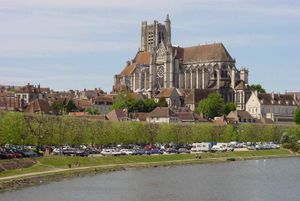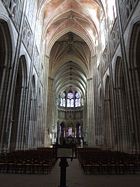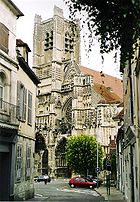
Cathédrale Saint-Étienne d'Auxerre
Encyclopedia

Auxerre
Auxerre is a commune in the Bourgogne region in north-central France, between Paris and Dijon. It is the capital of the Yonne department.Auxerre's population today is about 45,000...
, Burgundy
Bourgogne
Burgundy is one of the 27 regions of France.The name comes from the Burgundians, an ancient Germanic people who settled in the area in early Middle-age. The region of Burgundy is both larger than the old Duchy of Burgundy and smaller than the area ruled by the Dukes of Burgundy, from the modern...
, France, is known for its expansive stained glass windows.
Most of the Burgundian Gothic cathedral
Cathedral
A cathedral is a Christian church that contains the seat of a bishop...
was built between 1215 and 1233 above an 11th-century crypt
Crypt
In architecture, a crypt is a stone chamber or vault beneath the floor of a burial vault possibly containing sarcophagi, coffins or relics....
. Construction continued until the 1540s when the cupola, in Renaissance style that takes the place of one pinnacle on the completed tower, was completed. The first building campaign erected the chevet at the liturgical east end, followed later in the century by a new façade and the bases of new towers at the west end (still linked to the apse end by the nave of the old cathedral). Construction on the nave and transept
Transept
For the periodical go to The Transept.A transept is a transverse section, of any building, which lies across the main body of the building. In Christian churches, a transept is an area set crosswise to the nave in a cruciform building in Romanesque and Gothic Christian church architecture...
s proceeded slowly throughout the 14th and 15th centuries.

Guillaume de Seignelay, bishop of Auxerre decided to undertake the reconstruction of the older edifice about 1215, to which he set an example by contributing heavily and consistently from his own resources, and even bequeathed funds after his transfer to the see of Paris in 1220. The chevet was completed by his successor, Henri de Villeneuve (1220–34); he left 1000 livres for the project, but construction slowed after his death, hampered by a dearth of funds.
Stimulus was provided about 1270 by Jean de Châlons-Rochefort, who had recently become Count of Auxerre, having supported the Duke of Burgundy against his own brother, by marrying Alix, the heiress of Auxerre. He was the largest fief-holder in the Duchy and commemorated the new status of his fief of Auxerre by enriching the front of its chief ornament, the cathedral, whose Carolingian nave had been erected by his ancestor Hugh de Châlons, tenth-century bishop of Auxerre. Its program of sculpture was carried through long after his death and completed in the early fifteenth century.

The diocese
Auxerre was formerly an important diocese in GaulGaul
Gaul was a region of Western Europe during the Iron Age and Roman era, encompassing present day France, Luxembourg and Belgium, most of Switzerland, the western part of Northern Italy, as well as the parts of the Netherlands and Germany on the left bank of the Rhine. The Gauls were the speakers of...
, with a bishop as early as the 3rd century; the diocese was suppressed in 1821. A council held at Auxerre in 585 (or 578) under bishop Annacharius formulated forty-five canons, closely related in context to canons of the contemporary first
First Council of Lyon
The First Council of Lyon was the thirteenth ecumenical council, as numbered by the Catholic Church, taking place in 1245.The First General Council of Lyon was presided over by Pope Innocent IV...
and second Councils of Lyon
Second Council of Lyon
The Second Council of Lyon was the fourteenth ecumenical council of the Catholic Church, convoked on 31 March 1272 and convened in Lyon, France, in 1274. Pope Gregory X presided over the council, called to act on a pledge by Byzantine emperor Michael VIII to reunite the Eastern church with the West...
and the Council of Mâcon. "They are important as illustrating life and manners among the newly-converted Teutonic tribes and the Gallo-Romans of the time", the Catholic Encyclopedia asserts. Many of the decrees were directed against remnants of paganism
Paganism
Paganism is a blanket term, typically used to refer to non-Abrahamic, indigenous polytheistic religious traditions....
and non-Christian customs; others bore witness to the persistence in the early Middle Ages in France
France in the Middle Ages
France in the Middle Ages covers an area roughly corresponding to modern day France, from the death of Louis the Pious in 840 to the middle of the 15th century...
of certain ancient Christian customs. The canons of the council of 695
695
Year 695 was a common year starting on Friday of the Julian calendar. The denomination 695 for this year has been used since the early medieval period, when the Anno Domini calendar era became the prevalent method in Europe for naming years.- Byzantine Empire :* The people of Byzantium revolt...
or 697
697
Year 697 was a common year starting on Monday of the Julian calendar. The denomination 697 for this year has been used since the early medieval period, when the Anno Domini calendar era became the prevalent method in Europe for naming years.- Religion :* Approximate date of the Council of Birr,...
were concerned chiefly with the Divine Office
Canonical hours
Canonical hours are divisions of time which serve as increments between the prescribed prayers of the daily round. A Book of Hours contains such a set of prayers....
and ecclesiastical ceremonies.
See also:
- Saint Germanus of AuxerreGermanus of AuxerreGermanus of Auxerre was a bishop of Auxerre in Gaul. He is a saint in both the Roman Catholic and Orthodox churches, commemorated on July 31. He visited Britain in around 429 and the records of this visit provide valuable information on the state of post-Roman British society...
, bishop of Auxerre (died 448) - Desiderius of AuxerreDesiderius of AuxerreDesiderius of Auxerre was bishop of Auxerre, in France, from 614 to 621. He was from Aquitaine, and is mentioned in the Gesta pontificum Autissiodorensium, as well as the Chronicle of Fredegar....
, bishop, died 621) - Remigius of AuxerreRemigius of AuxerreRemigius of Auxerre was a Benedictine monk during the Carolingian period, a teacher of Latin grammar, and a prolific author of commentaries on classical Greek and Latin texts...
, theologian and teacher (died 908) - William of AuxerreWilliam of AuxerreWilliam of Auxerre was a French scholastic theologian and official in the Roman Catholic Church.The teacher by whom William was most influenced was Praepositinus, or Prevostin, of Cremona, Chancellor of the University of Paris from 1206 to 1209...
, theologian
External links
- "Welcome to Auxerre Cathedral"
- Auxerre Cathedral bibliography
- Photos
- Catholic Encyclopedia 1908: "Councils of Auxerre" "(Sens):Diocese of Auxerre"

